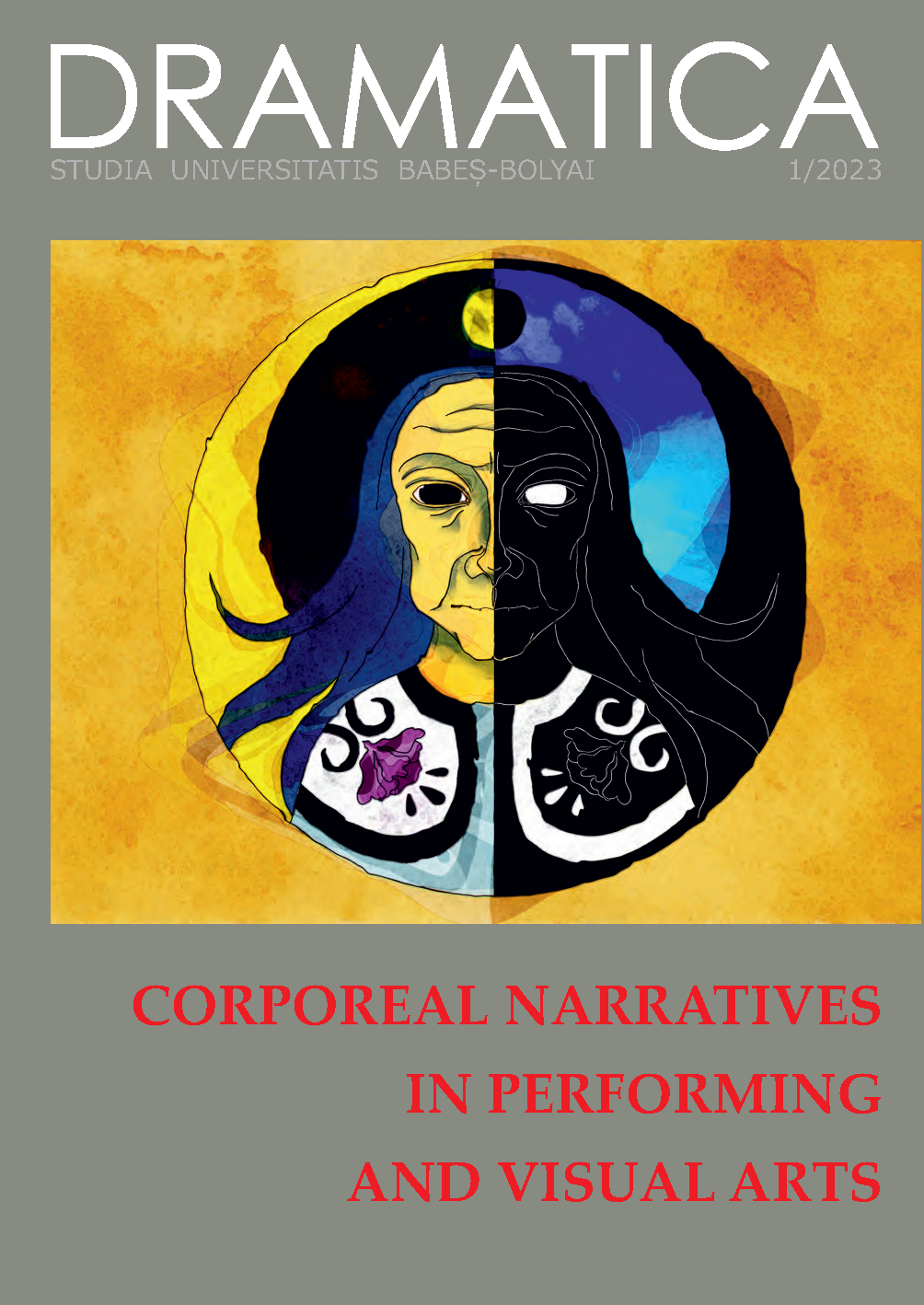The Witch’s Body as a Narrative and Symbolic Tool
DOI:
https://doi.org/10.24193/subbdrama.2023.1.01Keywords:
witches, body, narration, symbolic, visual arts, literature, cinema.Abstract
This paper aims to propose an exploration of the corporeality of witches insofar as it has been used as a medium or nexus for narratives, or as a symbolic sign in various artistic forms and arrangements. The starting point is the highlighting of an antithesis, which is permanently nuanced and overcome in the long evolution of culture, namely between the beauty of young witches and the ugliness of old ones. A first section of the article focuses on painting, looking at works by Baldung Grien, Salvator Rosa, Frans Francken, Luis Ricardo Falero. A second section looks at the corporeal duality that characterizes witchcraft and its resolution in synthesis in Vasile Voiculescu’s short story Magical Love. The last section is devoted to cinematographic works and how they have incorporated in their complex visual and textual narratives an ancient representational and iconographic tradition with roots in Renaissance and Baroque painting and in the literature of Greco-Latin Antiquity.
References
Bever, Edward. “Old Age and Witchcraft in Early Modern Europe.” In Old Age in Preindustrial Society, ed. by Peter Stearns, 150-190. New York: Holmes and Meier, 1982.
Blécourt, Willem de. “Chapter Twelve. The Witch in the Owen: Exploring Hansel & Gretel Witch Hunters.” In The Fairy-Tale Vanguard: Literary Self-Consciousness in a Marvelous Genre, edited by Stijn Praet, Anna Kérchy, 229-246. Cambridge Scholars Publishing, 2019.
Ferber, Sarah. “Body of the Witch.” In Encyclopedia of Witchcraft. The Western Tradition, Volume 1 A-D, edited by Richard M. Golden, 131-133. ABC-Clio, 2006.
Greene, Heather. Lights, Camera, Witchcraft: A Critical History of Witches in American Film and Television. Woodbury, Minnesota: Llewellyn Publications, 2021.
Guy Marica, Viorica. Baldung Grien. Bucharest: Meridiane, 1976.
Horace. Odes and Epodes, Edited and translated by Niall Rudd. Cambridge & London: Harvard University Press, 2004.
Hults, Linda C. “Baldung and the Witches of Freiburg: The Evidence of Images.” Journal of Interdisciplinary History, Vol. 18, No. 2. Autumn (1987): 249-276.
Jacques-Chaquin, Nicole. “Représentation du corps sorcier à l’âge Classique.” Revue des sciences humaines, n° 198 (1983): 51-68.
Macfarlane, Alan D. J. Witchcraft in Tudor and Stuart England. New York: Harper and Row Publishers, 1970.
Oliensis, Ellen. “Canidia, Canicula, and the Decorum of Horace’s Epodes.” In Horace: Odes and Epodes, Edited by Michèle Lowrie, 160-187. Oxford University Press, 2009.
Palou, Jean. La Sorcellerie. Paris, PUF, “Que sais-je?”, 1957.
Pelicier, Yves. “Le Corps de la sorcière.” In Le Corps à la Renaissance: Actes du XXXe colloque de Tours, 1987, 139-45. Paris, Aux amateurs de livres, 1990.
Pop-Curşeu, Ioan. “Circé à l’écran: portraits d’une sorcière séduisante ou la force de l’Eros.” In Etudes comparatives sur la sorcellerie. Anthropologie, cinéma, littérature, arts visuels, 25-53. Cluj-Napoca: Școala Ardeleană, 2021.
Pop-Curşeu, Ioan. “Dario Argento et la mère-sorcière: psychanalyse d’une image obsédante.” Studia Universitatis Babeș-Bolyai. Philosophia, vol. 65, nr. 1 (2020): 19-37, DOI:10.24193/subbphil.2020.1.02, http://www.studia.ubbcluj.ro/download/pdf/philosophia/2020_1/03.pdf
Pop-Curşeu, Ioan. “Le Meurtre de l’enfant dans les rituels de sorcellerie: commentaires sur un stéréotype culturel.” Revista de Etnografie şi Folclor / Journal of Ethnography and Folklore, New Series, 1-2 (2011): 19-32.
Pop-Curşeu, Ioan. “Signes apocalyptiques: l’infanticide magique et l’enfant monstrueux.” Ekphrasis. Images, Cinema, Theatre, Media, issue 2 (2012): 145-163.
Pop-Curșeu, I. and Ștefana Pop-Curșeu. “The Mask of the Witch: from Ritual to Carnival and Theatre.” Studia Universitatis Babeș-Bolyai. Dramatica, vol. 65, nr. 1 (2020): 17-50, DOI:10.24193/subbdrama.2020.1.01, https://dramatica.ro/index.php/j/article/view/29
Pop-Curseu, Ştefana. “Sorcières et sorcellerie dans le théâtre de Michel de Ghelderode.” Studia Universitatis Babeş-Bolyai, Dramatica, nr. 1 (2007): 44-59.
Rowlands, Alison. “Witchcraft and Old Women in Early Modern Germany.” Past and Present, nr. 173, Nov. (2001): 50-89.
Salerno, Luigi (and Ira Kohn, translator). “Four Witchcraft Scenes by Salvator Rosa.” The Bulletin of the Cleveland Museum of Art, Vol. 65, No. 7, Sep. (1978): 225-231.
Sandberg, Claire. “Boil and Bubble and Male Trouble: The Visual Representation of Masculine Anxieties in 16th Century Witchcraft Prints.” Renaissance Reframed, 28 Oct. 2020, https://renaissancereframed.com/2020/10/28/boil-and-bubble-and-male-trouble/
Shelley, Peter. Grande Dame Guignol Cinema. A History of Hag Horror from Baby Jane to Mother. Jefferson & London: McFarland & Company, 2009.
Sullivan, Margaret A. “The Witches of Durer and Hans Baldung Grien.” Renaissance Quarterly, vol. 53, nr. 2 Summer (2000): 333-401.
Tausiet, María. “Chapter Nine Witchcraft as Metaphor: Infanticide and its Translations in Aragon in the Sixteenth and Seventeenth Centuries.” In Languages of Witchcraft. Narrative, Ideology and Meaning in Early Modern Culture, Edited by Stuart Clark, 179-195. Houndmills: Macmillan Press, New York: St. Martin’s Press, 2001.
Voiculescu, Vasile. Povestiri II (Stories II). Bucharest: Editura pentru Literatură, 1966.
Walde, Christine. “Canidia and Erichto: Snapshots from their Postclassical Life.” In Ancient Magic and the Supernatural in the Modern Visual and Performing Arts, edited by Filippo Carlà and Irene Berti, 119-134. London, Oxford, New York: Bloomsbury Academic, 2015.
Willis, Deborah. Malevolent Nurture. Ithaca: Cornell University Press, 1995.
Zamora Calvo, Maria Jesús. Brujas de Cine. Madrid: Abada Editores, 2016.
Zika, Charles. Exorcising our Demons Magic, Witchcraft and Visual Culture in Early Modern Europe. Leiden & Boston: Brill, 2003.
Zika, Charles. The Appearance of Witchcraft. Print and Visual Culture in Sixteenth-Century Europe. London & New York: Routledge, 2007.
Downloads
Published
How to Cite
Issue
Section
License
Copyright (c) 2023 Studia Universitatis Babeș-Bolyai Dramatica

This work is licensed under a Creative Commons Attribution-NonCommercial-NoDerivatives 4.0 International License.


